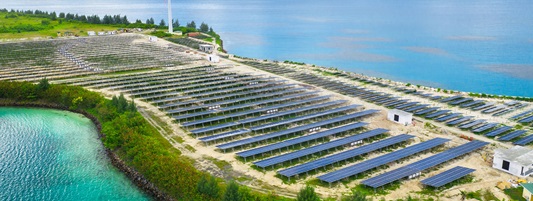Overview
As the world considers how to establish a path towards limiting global temperature rises by reducing greenhouse gas emissions, it is widely acknowledged that the power generation sector plays a critical role. The sector's role is critical because decarbonising the rest of the economy is dependent on increasing demand for renewable electricity, which accounts for one-third of total global carbon emissions (for example in electric vehicles and residential heating).
As the world considers how to establish a path towards limiting global temperature rises by reducing greenhouse gas emissions, it is widely acknowledged that the power generation sector plays a critical role. The sector's role is critical because decarbonising the rest of the economy is dependent on increasing demand for renewable electricity, which accounts for one-third of total global carbon emissions (for example in electric vehicles and residential heating).
IRENA works with energy and climate stakeholders to transform energy infrastructure across all energy subsectors in order to achieve net zero emissions using renewable energy sources such as solar, wind, storage, biomass, geothermal, or hydropower systems while balancing development goals and adapting to national contexts. We work with industry leaders to anticipate the impact of new technologies and to aid in the planning, implementation, and scaling of renewable energy technology deployment:
- Assist national stakeholders in SIDS and LDCs in understanding the most recent climate technologies and necessary system changes, such as technical barriers, enabling frameworks, capital investment requirements, scaling economics, and regulations.
- Provide energy and climate leaders with expert analysis and information on emissions reduction measures and enabling frameworks based on renewable energy technologies to help them strengthen their climate ambitions in line with the WETO 1.5°C scenario.
- Enhance climate action plans looking at quantifiable baselines, gathering and validating energy data with national parties, and formulating technical and operational recommendations.
- Bring together public and private disruptors and leading players in the renewable energy technology ecosystem and collaborate with organisations at the forefront of climate innovation to support the organisation of flagship activities under a number of international initiatives.
- We collaborate with grid operators, utilities, and power generation companies, particularly in SIDS and LDCs, to increase the grid's capacity to meet the rising demand for supply- and demand-side flexibility, and to improve the grid's quality and resilience.
Past Events
View more-
21-22 October 2019 Luxembourg, Luxembourg
IRENA at the Pentalateral Conference on Electromobility
-
6-9 May 2019 Beirut, Lebanon
Validation Workshop - Lebanon










